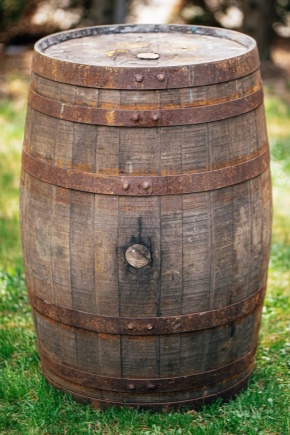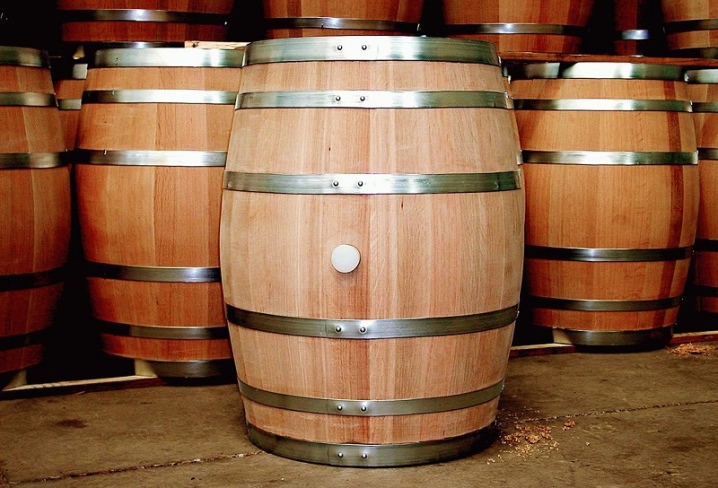Features of wooden barrels

The new barrel is able to improve the taste of the product, give it a unique taste and aroma, enrich color, and add transparency to drinks. To get so many advantages, you need to know which wood to use the cooper product from in certain cases. In the article we will tell you what and how barrels are made of, talk about their choice and proper operation.

What are they made of?
Wooden barrels are made from natural environmentally friendly material, they are sealed, strong and durable. Drinks and salting in such containers retain their taste and color, and new barrels even enrich their taste. Not every tree species is suitable for cooper business - far fewer options are used here than in the construction and furniture industry, but there is still a choice.


Linden
The wood is soft its flexibility in handling simplifies the work of the cooper. On the scale of strength, linden takes the middle place between strong and weak tree species. It retains moisture well and is endowed with antiseptic properties.
Sensory evaluation of products from linden barrels, performed in all organoleptic categories (taste, color, smell, structure), is always at its best. The product retains its very qualities for a long time, without borrowing extraneous properties from wood.
Such barrels are invaluable for storing honey, caviar, meat, bacon, fish, but for salting it is better to choose other products.


Oak
Oak wood is the most respected material in cooper's business. Products made from it are beautiful, strong, durable.... The presence of moisture only enhances their strength. Oak can influence the color, aroma and taste of products.
Barrels are made from different types of oak, and this should be taken into account when choosing a product. For spirits, products from French, American and rock oak are suitable. The rest of the varieties are suitable for pickling vegetables, storing bacon, caviar, fish and meat.
Light-colored foods (cabbage, apples) may darken, and honey may acquire a foreign uncharacteristic aroma.


Pine
Spruce and pine are soft materials that do not have high strength. But they significantly benefit in cost, for example, in oak barrels. Products from these tree species are undesirable for food products, a persistent resinous smell can affect the taste and aroma of the contents of coniferous containers not for the better.


Cedar
This representative of the flora, unlike pine, does not contain a resinous odor and is suitable for all types of products... Even milk can be stored in cedar products without worrying about a change in taste. The wood of the plant is soft, but at the same time durable.
Due to the large amount of phytoncides, products in barrels do not deteriorate, do not become moldy.


Aspen
Durable, but quite malleable material for processing, does not chip and crack. In a humid environment, it is prone to swelling, therefore, pickles, not drinks, are stored in aspen barrels.
The bactericidal properties help the food to resist decay.


Larch
By its strength, larch is superior to oak products, therefore it is expensive. Barrels from it can serve for centuries, and it will be very difficult to damage them.


Where is it used?
We figured out in which barrels these or those products are stored.But cooperage products are not only made for food needs - there are many ways to use the wonderful qualities of new and old barrels.
Oversized cedar models are produced for saunas, where they are used as hot tubs. Particularly interesting are decorative items from waste barrels, which serve to decorate interiors, they are used in landscape design, they are installed in dachas and in the gardens of private houses as flower beds. We offer a selection of photographs in which the barrels are presented as a decor or an unusual functional element:
-
the most common is the use of cooperage products as a container for flowers;

-
two barrels and a board get impromptu table;


-
it's easy to make from an old cooper product beer table with "refrigerator" or an unusual bar;



-
surprises and delights wash basin in a rustic style;

-
unusual products include furniture from wooden barrels.

Selection rules
It is important to choose a barrel for specific purposes, and not for appearance. When it comes to alcoholic beverages, even volume matters. The smaller it is, the more actively the aging processes will take place, the faster the product will acquire a rich color and aroma.
For storing wines, products are chosen from certain varieties of oak, denser and more aromatic. The color saturation also depends on the degree of roasting - the more intense it is, the darker the shade of the drink becomes. For white wines, choose a weak type of roasting.
If you plan to keep products with their own valuable aroma in the barrel, you should give preference to wood with a neutral odor - linden or cedar.
Barrels made of colored tree species give a noble shade to dark drinks, appetizingly color pickles and sauerkraut, but light fruits and vegetables will lose from the activity of color.
Spruce and pine containers are best used for technical or household purposes not related to storing food.
The activity of the resins will not cause poisoning, but will reduce the nutritional value of the contents.



How to do it yourself?
Making homemade barrels at home is difficult, but possible. Initially, drawings are made, calculations, for example, barrels for 200 liters, prepare templates-templates for boards. We offer a technology for the manufacture of a cooper product with firing from boards (rivets) obtained by parsing a log of any suitable suitable wood. In addition to rivets, the bottom and the lid are made to collect the barrels, they are usually the same, they are called bottoms. You will need a steel hoop to secure the rivets.


Before starting work, prepare the necessary tools and materials:
-
circular and long jointer;
-
axe;
-
scraper for working in the barrel cavity;
-
post gate;
-
heel for making a hoop;
-
clamps for barrel mounting;
-
well for working with the edges of the boards;
-
a chimpanzee for working with dons;
-
staples.
It is much easier to assemble the product on a cooper's workbench with a vice, if available.
When the tools and materials are collected, they begin to make the barrel itself.


Making rivets
To begin with, the wood is dried in drying ovens, since the material will naturally dry from 3 months to a year. Next, planks are made radially from a solid log:
-
the first split of the log is made strictly in the center, it divides the deck in half;
-
4 and then 8 identical parts are obtained from two halves by splitting;
-
large parts are dismissed in half lengthwise, then across by 2-5 planks, depending on the dimensions of the log.
The resulting blanks are cut and left for long-term drying, or special dryers are used. Then they start making rivets:
-
markings are made on the workpiece using templates;
-
with the help of an ax and a plane, the surfaces are planed and rounded;
-
the edges are cut with a fret, the inside is cleaned with a scraper, then processed with a jointer.


Making hoops
Given the shape of the barrel, for one dimensional product, you will need three types of hoops - bunch (central, large), chime (medium), neck (small). The number of hoops of different types depends on the size of the barrel, they can be from 2 to 6 or more.
Steel blanks are rolled into a circle with a hammer. To assemble the barrels, they are overlapped. At the joints, several holes are drilled for rivets.

Barrel assembly
Having chosen a clean, flat surface, proceed to the assembly of the cooperage product.
-
Begin assembly from the neck, the smallest hoop... Three initial plates in the form of spacers are brought into it and fixed with steel brackets. Having installed the structure vertically on the rivets (hoop up), continue the assembly.
-
Now slowly, gradually, fill the hoop with rivets, securely fixing them with clamps (staples).
-
With pins and a hammer the rim is firmly planted on the planks.
-
The lower hoop is put on and beat off in the same way.
-
Then at the top and bottom of the barrel produce and align the ends.
-
Inside the structure Scrape off all irregularities with a scraper.
-
The ends are brought with a plane to perfect condition.
-
Then cut grooves to install the bottom.
-
So that the bottom can enter the grooves, the pressure of the rivets is weakened. When the bottom is in position, the hoop is put back in place.



Burning
Firing is performed to seal the rivets, it also affects the taste of beverages and food for the better. To perform firing, the barrel is turned over on its side. Inside it, shavings of fruit trees are set on fire. The product is gradually rolled, observing the uniformity of the process.
The fire must not be fanned; care must be taken not to damage the inner surface of the cooper product.
The working process is stopped at different times, thereby obtaining barrels with three degrees of roasting: low, medium and high - for white wine, cognac and red wine.

Operating tips
The operation of cooperage products includes not only the process of storing products, but also the preparation, care and maintenance of empty containers.

Preparation for use
An oak barrel contains a large amount of tannins that can spoil the color and taste of the drink. In this regard, a new product is leached before use, the process can take up to 7 weeks. For barrels made from other wood species, a week of soaking is sufficient.
When preparing for operation, the barrel is filled with water, which is changed every 2-3 days. After a couple of weeks, the liquid can be tasted: leaching is considered complete if the water becomes transparent and loses the taste of wood. If this does not happen, continue soaking.
Next, proceed to processing. The barrel is filled halfway with boiling water with the addition of soda, tightly closed and rolled over the surface so that the walls are completely washed out. After half an hour, the water is drained. The procedure is not carried out with wax-treated containers.
Next, the container is poured with warm clean water, drained and fumigated with sulfur, giving it time to dry completely.

Wooden barrel storage
The empty container is stored in a well-ventilated environment with low temperature and humidity over 70%. A high percentage is necessary to maintain natural moisture in the wood product. If the hoops do dry out and loosen, the barrel should be filled with water and left for some time until it returns to its original shape.
During storage and operation, the container should be on stands, providing ventilation to the bottom.














The comment was sent successfully.